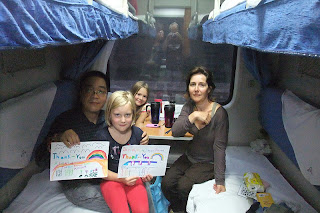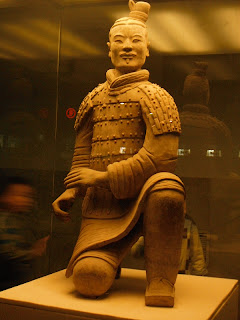
There are two big tourist draws near Chengdu and today we head out across town to catch the public bus for the 2 hour trip to Leshan and the Giant Buddha. At the bus station we then take a taxi, (after much negotiation on rates and the use of the meter) to the Buddha complex. The Leshan Giant Buddha was built during the Tang Dynasty (618–907AD). It is carved out of a cliff face that lies at the confluence of the Minjiang, Dadu and Qingyi rivers in the southern part of Sichuan province in China, near the city of Leshan. The stone sculpture faces Mount Emei, with the rivers flowing below his feet. It is the largest carved stone Buddha in the world and it is by far the tallest pre-modern statue in the world.


We are discovering that no Handley day trip is complete without atleast a steep hill, long set of stairs or slope climb and today is no exception! The level of humidity on the way up in comparison to the city is a bit of a shock as we thought it would be cooler the higher we climbed. Along the way there are several small shrines carved into the rock face, complete with candles, incense, statues and offerings of flowers left by worshippers on their way up to the main attraction. According to legend Lingyan Hill with its dense forest and cave offered good shelter for a white tiger, while at the foot of the hill, the three rivers provided a black dragon with waves to play in. The dragon and tiger after hearing the Buddhist sutras decided to dedicate themselves to Buddhism and became guardians to protects Buddhists. Cen Shen a Tang Dynasty poet wrote while visiting Lingyan Hill "Wind blows over the tiger's lair and rain drops to fill the dragon's pool". This site later named Dragon Pool and Tiger Lair has been a popular destination in Lingyun Hill since the Tang Dynasty.


At the top there is another beautiful Wuyou Buddhist temple, complete with the most beautiful and ornate images, carved and decorated in the most sumptuous style.


 The Big Buddha is... well... BIG! Sitting, literally on the river bank and carved into the rock face. We start at the head and get our first glimpse of the statue in it's enterity. It is HUGE!
The Big Buddha is... well... BIG! Sitting, literally on the river bank and carved into the rock face. We start at the head and get our first glimpse of the statue in it's enterity. It is HUGE!
 Construction was started in 713, led by a Chinese monk named Haithong. He hoped that the Buddha would calm the turbulent waters that plagued the shipping vessels traveling down the river. When funding for the project was threatened, he is said to have gouged out his own eyes to show his piety and sincerity. After his death, however, the construction was stuck due to insufficient funding. About 70 years later, a jiedushi decided to sponsor the project and the construction was completed by Haitong's disciples in 803.
Construction was started in 713, led by a Chinese monk named Haithong. He hoped that the Buddha would calm the turbulent waters that plagued the shipping vessels traveling down the river. When funding for the project was threatened, he is said to have gouged out his own eyes to show his piety and sincerity. After his death, however, the construction was stuck due to insufficient funding. About 70 years later, a jiedushi decided to sponsor the project and the construction was completed by Haitong's disciples in 803.Apparently the massive construction resulted in so much stone being removed from the cliff face and deposited into the river below that the currents were indeed altered by the statue, making the waters safe for passing ships.
At 71 metres (233 feet) tall, the statue depicts a seated Buddha with his hands resting on his knees. His ears are 7m, the shoulders are 28 metres wide, his big toes are 8.5m long and his smallest toenail is large enough to easily accommodate a seated person. There is a local saying: "The mountain is a Buddha and the Buddha is a mountain". This is partially because the mountain range in which the Leshan Giant Buddha is located is thought to be shaped like a slumbering Buddha when seen from the river, with the Leshan Giant Buddha as its heart. To fully appreciate the Buddha's magnitude we descend the steep, winding staircase carved in the cliff face and thank our lucky stars that we are here when it is relatively peaceful and not in the Golden Week throngs. It was tricky enough in the quiet! We also get a good view of the tour and speed boats fighting against the current as their passengers (complete with waterproof ponchos to protect from the spray) view the Buddha from a different angle.
Once we reach the bottom of the statue we then have to make the punishing and hot and sticky climb back up the other side through a series of steep staircases and tunnels, gradually working our way past groups of wheezing, puffing and panting Chinese as we "mountain goat" upwards to find the exit.The exit proves difficult to find, we take several wrong turns as the signboards don't seem indicate the way out. We do stumble upon the riverfront and this beautiful bridge a little way upstream, but patience, energy and sense of humour are beginning to run out as we have walked up and down more than our fair share of stairs by this point.


We see a sign "South Gate" and decide this must be one of the exit points - it was a cruel trick! It was merely a gate into the Buddha site from another scenic area - but the unusual typo, breaks the tension!
Eventually we do escape and head back to the bus station to make our way home. Amazingly - even on the motorway back to Chengdu with no apparant reason, the bus driver honks his horn regularly at approximately 30 second intervals. He also talks as loudly as his hooter on his mobile phone for the duration of the journey mostly saying "Waaaiiiih", which we now understand to be hello, ok, yes or all of the above!


The taxi from the bus depot drops us at the end of our street and we walk past the teahouses which double as venues for Chinese Opera performances in the evenings - These costumes are on display as advertisements for the shows and were beautifully embroidered.
















































